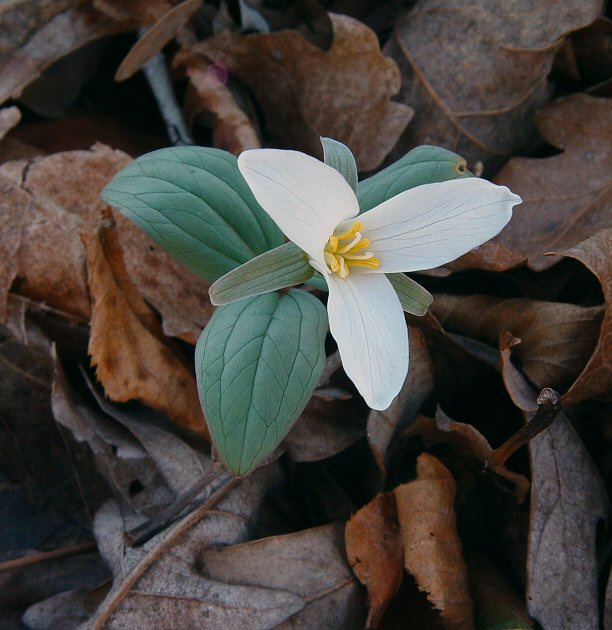Trillium nivale Riddell
Snow Trillium

Native
CC = 9
CW = 5
MOC = 11
© DETenaglia
Trillium nivale RiddellSnow Trillium | |
 |
Native CC = 9 CW = 5 MOC = 11 |
© DETenaglia |
|
Family - Liliaceae Habit - Perennial forb from a rhizome and thickened roots.
Stems - Erect, to 10 cm, single from the base, simple, herbaceous, glabrous, reddish, somewhat 5-angled.
Leaves - Single whorl of 3, entire, petiolate. Petioles 3-4 mm long, mostly glabrous but with minute translucent papillae on the margins (use a lens to see). Blades 7-20 cm long, 2 or more times longer than wide, elliptic to ovate, the tips usually broadly pointed, but not acuminate, shiny silvery-green below, pale bluish-green above, not mottled, the upper surface lacking stomates or with only a few near the tip, glabrous above, with papillae on the margins, with 5 main veins. Lateral veins reticulate. Veins impressed above, expressed below.
Inflorescence - Solitary terminal flower, erect or ascending above the leaves. Peduncle 1-3 cm long, glabrous, purplish. Flowers nodding slightly or erect.
Flowers - Sepals 3, spreading to ascending, 8-25 mm long, lanceolate, not purplish tinged. Petals 3, 12-35 mm long, elliptic to narrowly obovate, white, sometimes slightly pinkish tinged at the base, glabrous. Stamens 6-20 mm long, usually more than half as long as the petals. Stamens 6, alternating smaller and larger, erect, distinct. Ovary sessile, superior, glabrous, with 3 rounded lobes. Styles 3.
Fruits - Ovoid to ellipsoid berries, nodding below the leaves. Flowering - March - April. Habitat - Mesic upland forests on steep, open, north-facing slopes above streams, on limestone and chert substrates. Origin - Native to U.S. Lookalikes - None close. Other info. - This small species is the smallest Trillium in Missouri and the first to bloom each spring. The plant is uncommon in the state and can only be found in a handful of counties. Its very selective habitat limits its range. Outside of Missouri it is found in a handful of upper Midwestern states, but is uncommon in most places. It is an easy species to identify in the field (if you're lucky enough to find it) because of its small size, habitat, and white flowers. Plants are usually found in large numbers in a given area. Photographs taken in Lincoln County, MO., 3-19-04 (DETenaglia) and 3-21-2020 (SRTurner). |